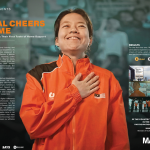When it comes to breakthroughs, businesses often strike it big when organizations connect a multitude of different, disparate ideas and approaches into something truly special.
Solving tough problems requires fresh thinking, and this is where the fusion of data and design can bring great promise to the occasion.
Recent advances in artificial intelligence (AI) and other analytics can enable decision makers to activate the wonders of product development right up to customer engagement.
Qualitative insights, creativity and a relentless focus on end-user needs is of course focused at product and service innovation.
According to a McKinsey & Co, an average of 10 to 30 percent performance improvement is seen among companies that interweave data and design capabilities to solve business problems.
Companies need to move from silos to squads, from disconnected workflows to deep synchronicity of skills and from product innovation only to operations-wide use.
In a study of the design practices of 300 companies, the top financial performers had integrated design across the organization rather that creating design units within specific departments.
Apparently, the most effective integration of design is through the assembly of “squads” that include both data experts (data scientists, data engineers and so on) and designers (design researchers, visual designers and others).
When data and analytics capabilities come together, a center of excellence can be created. 60 percent of companies successfully scaling analytics to solve problems across the organization use cross functional teams.
Over the last 10 years, the use of data and design has ballooned in the world where born-digital companies are merging these disciplines as a natural evolution of their culture.
These companies have fertile environments, with agile practices and multi-disciplinary mind-sets that allow diverse approaches to easily intermingle and ultimately blossom together.
In reality, most companies have institutional silos, disconnected workflows and misconceptions of design.
Moving forward, the more data and design experts are brought together and work together, the earlier and wider their sphere of influence can be.
Greater rewards will always be on offer to companies who choose to break the conventions, defy expectations and explore new horizons in order to reimagine their future.
Source: McKinsey & Co.
MARKETING Magazine is not responsible for the content of external sites.











